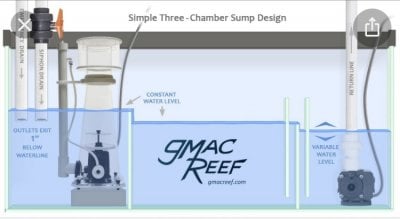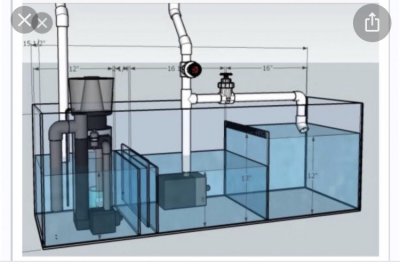I recently purchased a second hand 46 gallon bow front with the stand and was going to upgrade my current nano 10 gallon to this new tank at some point.

I have never drilled a tank before but I have drilled glass before so I'm confident I can do this. The tank has a tempered glass sticker so I made sure to check the back glass using the white lcd and polarized lenses method. The back and sides shouldn't be polarized based on my test so it should be safe to drill right?
I wanted to build my own sump and I think I'll only be able to squeeze a 10 gallon or 20 gallon long under my stand, so I've drawn up what it might look like along with some potential plumbing.

I wasnt going to drill a spot for the return bulkhead but figured why not if I'm already drilling for the overflow. I'm sure I could use the same drill bit and template that comes with the eshoppes eclipse m overflow I plan on using. I also plan on using the BH50 skimmer from reef octopus and the DC4000 return pump from Jecod.
I wanted to post this as sort of a build thread that I can update as the build progresses. I'm opened to all forms of help and suggestions considering it's my first time doing this. Currently I'm looking for reassurance that everything I'm doing is on track. Thanks a million and I'll keep updating this
I have never drilled a tank before but I have drilled glass before so I'm confident I can do this. The tank has a tempered glass sticker so I made sure to check the back glass using the white lcd and polarized lenses method. The back and sides shouldn't be polarized based on my test so it should be safe to drill right?
I wanted to build my own sump and I think I'll only be able to squeeze a 10 gallon or 20 gallon long under my stand, so I've drawn up what it might look like along with some potential plumbing.
I wasnt going to drill a spot for the return bulkhead but figured why not if I'm already drilling for the overflow. I'm sure I could use the same drill bit and template that comes with the eshoppes eclipse m overflow I plan on using. I also plan on using the BH50 skimmer from reef octopus and the DC4000 return pump from Jecod.
I wanted to post this as sort of a build thread that I can update as the build progresses. I'm opened to all forms of help and suggestions considering it's my first time doing this. Currently I'm looking for reassurance that everything I'm doing is on track. Thanks a million and I'll keep updating this
























